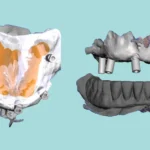Doctor, how often do you see a child or young adult in your clinic complaining that their teeth just don’t look right, or maybe a tooth isn’t erupting in its expected spot? You take a panoramic X-ray to get the full story, and then you’re hit with a surprise: two neighboring teeth have completely switched places! Each tooth has emerged where its adjacent counterpart should have been.
This fascinating condition is what we term Transposition. It’s one of those cases that can genuinely puzzle anyone who hasn’t encountered it before.
What Exactly is Transposition?
In the simplest terms, transposition is considered a developmental anomaly. It happens when two adjacent teeth in the same dental arch literally swap their positions. So, one tooth erupts in the spot of the other, and vice-versa.
How Does It Appear on X-rays? (Radiographic Features)
On a radiograph, the situation is usually very clear-cut and hard to miss:
Location
Most frequently, transposition occurs involving the permanent canine.
Edge
The borders of the two transposed teeth are typically very well-defined.
Shape
Each of the teeth that have swapped positions retains its completely normal tooth shape. A canine still looks like a canine, and a premolar still looks like a premolar.
Internal Structure
Just like any normal tooth, the outer part appears radiopaque (due to the enamel and dentin), while the inner part is radiolucent (because of the pulp chamber and root canal).
Other Notable Features
There are no other distinguishing signs besides the actual positional swap.
Number
This condition always involves two adjacent teeth.
In the accompanying image (if applicable), you’d notice something quite unusual: the lateral incisor positioned next to the first premolar, while the canine has migrated to sit right beside the central incisor. It’s quite the mix-up!
Key Points You Absolutely Need to Know
-
The most common type of transposition we encounter is between the canine and the first premolar.
-
It can manifest in either the maxilla (upper jaw) or the mandible (lower jaw), but it’s significantly more prevalent in the upper arch.
-
This positional swap can be complete, meaning both the crowns and roots have transposed, or incomplete, where only the crowns have switched places.
-
Transposition is often associated with the presence of other dental anomalies.
Why is It Clinically Important? (Clinical Significance)
Naturally, transposition can lead to both aesthetic and functional issues for the patient.
-
It significantly complicates orthodontic treatment planning.
-
There’s an increased potential for caries risk due to the unusual positioning of the teeth, which can make proper cleaning challenging.
How Do We Manage It?
Treatment strategies depend heavily on the severity of the case and the patient’s age. Options typically range from simple observation to orthodontic correction, or even extraction in some of the more complex scenarios.
One Last, Crucial Point
When you diagnose a case of transposition, it’s incredibly important to conduct a full evaluation of the entire dentition. As mentioned, it can often be linked with other underlying dental issues. Early detection of this condition invariably helps us formulate a much better treatment plan and manage it more effectively.




















